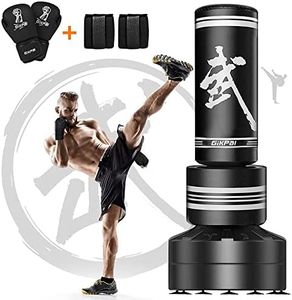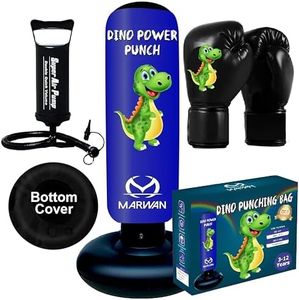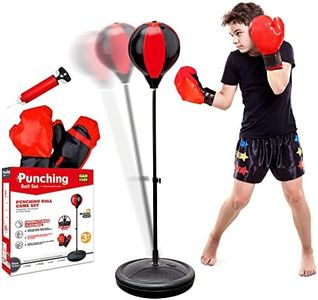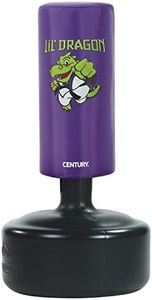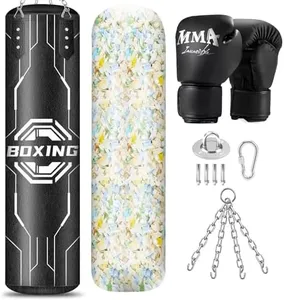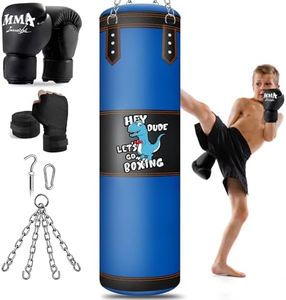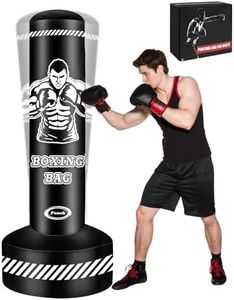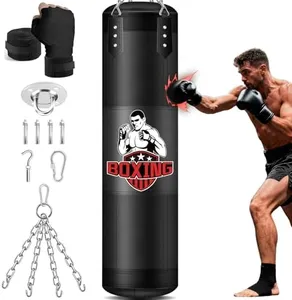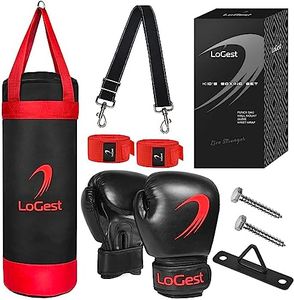10 Best Boxing Bags For Kids 2025 in the United States
Our technology thoroughly searches through the online shopping world, reviewing hundreds of sites. We then process and analyze this information, updating in real-time to bring you the latest top-rated products. This way, you always get the best and most current options available.

Our Top Picks
Winner
Marwan Sports Kids Punching Bag Toy Set, Inflatable Boxing Bag Toy for Boys Age 3-12, Ninja Toys for Boys, Christmas,Birthday Gifts for kids 4,5,6,7,8,9,10 Years Old (Blue Dino)
Most important from
2871 reviews
The 2024 Upgraded 5-in-1 Kids Punching Bag Set by Marwan Sports is a well-rounded choice for children aged 4 to 12 who want a safe, fun way to practice boxing and martial arts. It stands 63 inches tall and weighs about 1.3 kg, making it easy to move and suitable for young users. The punching bag is inflatable and made from thick 0.5mm PVC and faux leather, which offers good durability and can handle over 10,000 strikes without losing air—great for energetic kids. Its wider base and three-air-chamber design provide stability and quick bounce back, which helps children improve reaction time and coordination in a safe way.
The package includes kid-sized 6oz boxing gloves, a pump for fast inflation, and a base cover for easy setup, so you get everything needed to start right away. However, the bag is inflatable rather than filled with traditional materials like sand or foam, which means it may feel less solid during punches but is lighter and safer for kids. The base is designed for floor standing, not for wall or ceiling mounting, and while the bag is tall enough for kids up to pre-teens, it does not feature adjustable height, so it may not perfectly fit all ages or growth stages.
Parents looking for a lightweight, stable, and complete beginner boxing set will find this product effective in promoting physical activity and confidence in young children, especially those interested in martial arts. Its support of autism awareness adds a meaningful cause to your purchase. The main trade-off is that it lacks adjustable mounting options and height settings, which some might find limiting as kids grow.
Most important from
2871 reviews
QPAU Inflatable Punching Bag, 48 Inch Stable Inflatable Boxing Bag for 3-6 Kids,Dinosaur Toy & Gifts for Boys and Girls, Kids Boxing Set for Practicing Karate, Taekwondo
Most important from
2199 reviews
The QPAU Inflatable Punching Bag is designed for kids aged 3-6 and stands at 48 inches tall, making it a suitable size for young children. One of its key strengths is its lightweight nature, weighing only 1.08 kilograms, making it easy to move around and set up both indoors and outdoors. Made from durable PVC material, it can withstand numerous punches and kicks, ensuring longevity even with frequent use.
The dinosaur design is appealing to young children and can encourage them to be active and engage in physical play, promoting balance, strength, and coordination. The inflatable nature of the bag means it is soft and safe for kids, reducing the risk of injury during playtime. However, as with any inflatable product, there's always a risk of it puncturing or leaking, which may require periodic maintenance or repairs.
Additionally, since it’s only 48 inches tall, older or taller kids might find it less challenging or engaging. The product includes boxing gloves and a 90-day warranty, offering a decent package for its price. Parents looking for a fun, safe, and engaging way to keep their young children active might find this punching bag a great addition to their home.
Most important from
2199 reviews
Century Kids Kick - Youth Punching Bag, Freestanding Training Bag, Adjustable Height, for Boxing, MMA, Stress Relief, Fitness, Karate, Kick Boxing, and Sparring
Most important from
89 reviews
The Century Kids Kick - Youth Punching Bag is a freestanding training tool designed for young martial artists engaged in boxing, MMA, karate, and similar sports. Weighing approximately 170 lbs when its base is filled with water, this bag offers stability and durability. The bag itself measures 10.5 inches in diameter and 26 inches tall, while the base is 22 inches in diameter and 12 inches tall.
Height adjustability from 37 to 52 inches makes it suitable for growing children, ensuring that it can be used as they develop their skills. The outer material is nylon, which is durable and capable of withstanding regular punches and strikes. This punching bag is made in the USA, adding a layer of trust in its quality and craftsmanship.
However, a few aspects to consider are the significant weight when filled, which might make it challenging to move, and the potential need for additional filling if water is not dense enough for some young users.
Most important from
89 reviews
Buying Guide for the Best Boxing Bags For Kids
Choosing the right boxing bag for kids involves considering several factors to ensure safety, durability, and enjoyment. It's important to select a bag that matches the child's age, size, and skill level. This will help them develop their boxing skills effectively while minimizing the risk of injury. Here are some key specifications to consider when picking a boxing bag for kids.FAQ
Most Popular Categories Right Now
